These pages are best viewed at 1024 x 768 x 32 bit monitor resolution |
| This Identification Guide for Lionel Electric Trains covers the "Post-war Era" only from 1945 until 1969. |
|
|
 |
|
| ALCO FA EMD F-3 |
EMD GP-7 & GP-9 EMD NW-2 |
FM TRAINMASTER GE 44 TON |
|
At the bottom of this page are indexed those diesels that we’ve researched listed in Numerical order. If the diesel has no number refer to our No Number listing below. ALCO (American Locomotive Company) |
 |
|
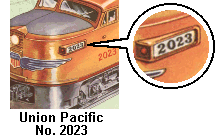 |
The coil coupler was also replaced with a magnetic disc coupler. This coupler bar, or strut, produced for these units after 1957, caused Lionel a lot of problems and they offered a replacement part (No. 204-78 Nose Support) to all of their service stations. In the last years of production the front coupler would be completely removed and the coupler pocket filled in. |
Collectors should always check to see if there is any battery damage in any of these diesels. |
  |
|
|
| EMD (Electro Motive Division of General Motors) |
 |
|
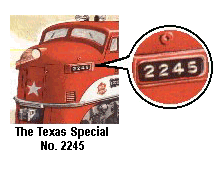 |
These first two models would go through numerous number changes in the years that they were in production, thus No. 2333 begat 2343 begat 2353...you get the idea. Each time this happened Lionel would invariably remove some of the detail that was inherent in the first production, to try and reduce the cost of assembly. By the time the final 2383 version of the Santa Fe was issued, it was a shell of its former self. The horizontal motors were replaced in 1955 with vertical worm drive motors that just didn’t sound the same. Gone also were the electronic coil couplers to be replaced with magnetic discs. |
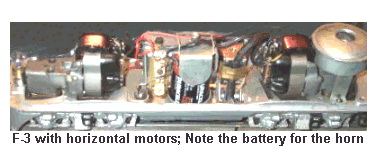 |
In 1955, Lionel began producing these engines for O27 sets. They changed the number designation to begin with "22" instead of the O Gauge "23." The Santa Fe was again the first into production with the number 2243 followed by the No. 2245 Texas Special. The Texas Special is the only one of these O27 engines to come with portholes. These engines came with one instead of two vertical worm drive motors. Lionel did not change the physical dimensions of these diesels for use on O27 Gauge track, and those that were run extensively over early versions of the No. 1122 O27 Switches will show evidence of scrapes on the center fuel tank, where the diesel scrapped the switch machine housing. Refer to the Track Identification Page for details on locomotive and rolling stock compatibility. |
 |
Lionel would produce the F-3 in quite a few other road names. Each of these stayed in production only a couple of years during the mid nineteen fifties, with the Canadian Pacific No. 2373 in production only one year being the rarest. |
|
|
 |
|
|
Issued mainly in O27 Gauge sets, they would also be seen in O Gauge sets. There were never any number designations on the number boards. Instead, there would always be a four-digit number shown somewhere on the side of the diesel. Lionel would continue to issue these diesel workhorses on a regular basis until 1965. |
 |
Most of the GP-7’s have a horn. The battery to power the horn was installed in the fuel tank between the trucks. We’ve included the insruction sheet on how to do this here. |
 |
|
These diesels, like the "other" road named F-3’s, were produced only one or two years each in the late-fifties and early sixties and most are hard to come by. The rarest is the Northern Pacific No. 2349 that was available in 1959 and 1960. Lionel would continue to produce this engine until 1966. |
 |
Most of the GP-9’s have a horn. The battery to power the horn was installed in the fuel tank between the trucks. We’ve included the insruction sheet on how to do this here. |
|
|
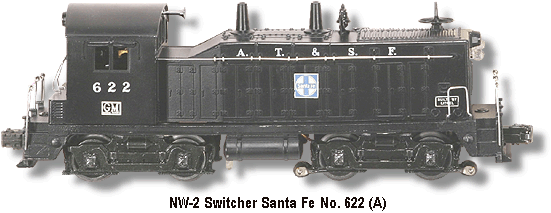 |
|
 |
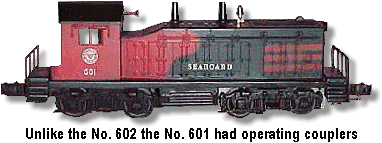 |
All subsequent NW-2s would have three-digit designations indicated somewhere on the body, and would be issued in O27 sets. The couplers, like other Lionel diesels would, over the years, change from electronic coil, to magnetic disc, to finally plastic dummy. This diesel would be in production up until the end of the post-war period in 1969. |
|
|
| Fairbanks-Morse |
 |
|
 |
First produced in 1954, it would see only three road names and two major variations. Lionel would, however, reissue the Virginian version of this diesel in 1965. The Virginian, that usually came in YELLOW and BLUE colors, is the only version that does not have the four digit production number printed on the side of the cab. They are: No. 2331 produced 1955-58, and No. 2322 produced 1965-66. In the first year of production Lionel produced the Virginian in striking YELLOW and BLACK colors and this is one of the major variations of this class of diesel. The other is the MAROON roofed version of the No. 2321 Lackawanna which was the first issue of this diesel in 1954. |
 |
The Southern Pacific Trainmaster No. 0000 was made as a possible production number sometime in the mid-nineteen fifties. This is one of many prototypes that Lionel produced but never put into production. These are very rare and are seldom seen. We show this one here for reference, but it is not listed in the Master Index. |
 Courtesy of J. Sattler Collection |
|
|
| General Electric |
|
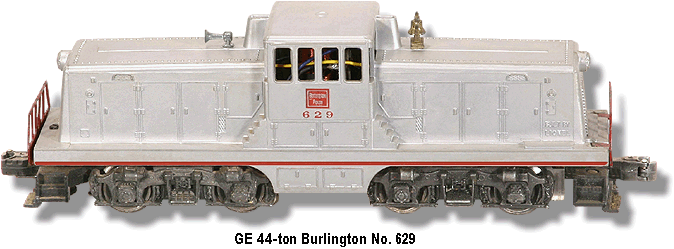 |
|
|
 | ||
|
|
||
 | ||||
| We’ve listed these unnumbered diesels in order by their color, and type. The types listed are: ALCO FA: defines ALCO Diesel Units. NW-2: defines EMD Diesel Switchers. |
||||
|
|
|
|
|